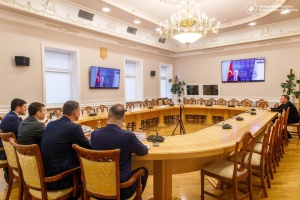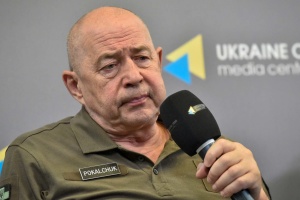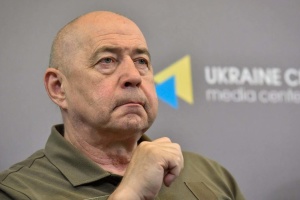
“Evil Nazis against woman and child”: Russian propagandists renounce their own fake targeting Ukraine Army
However, it was also the Russian propagandists who debunked the piece later the same day.
The Center for Strategic Communication and Information Security explains how the video feeds into a certain information attack pattern and how it is tied to the fake story of the “desecration of the Quran” spun earlier.
How the video was posted
The clip was uploaded on the afternoon of March 27. It was first published simultaneously by Telegram channels “Svezhesti” and “SHOT NEWS,” which have been repeatedly employed to spread anti-Ukrainian fakes, as well as the resources of the popular Russian image platform “Dvach” (Telegram channels “Dvach,” “Nyusach,” and the Twitter profile “Dvach.”).
A network of Telegram channels, information websites, TV channels, pages on social networks, etc. joined in on spreading the fake. More than 200 posts containing the clip were created on March 27-28 on Telegram and VKontakte alone, that’s besides shares and further spread across comment sections.
This video with a comment in English was posted on Twitter by the official accounts of the Russian Ministry of Foreign Affairs and Russia’s Embassy in the UK.
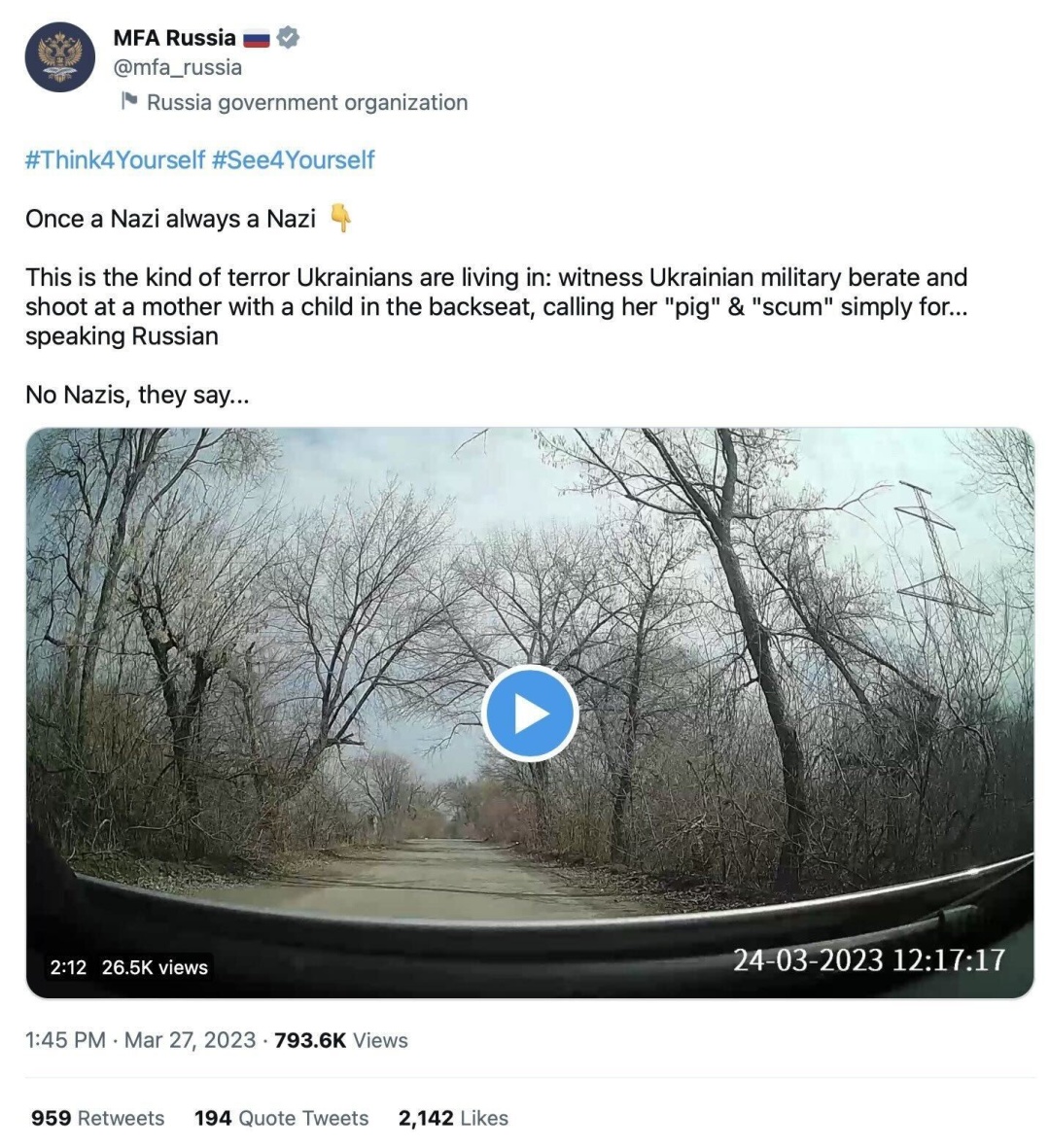
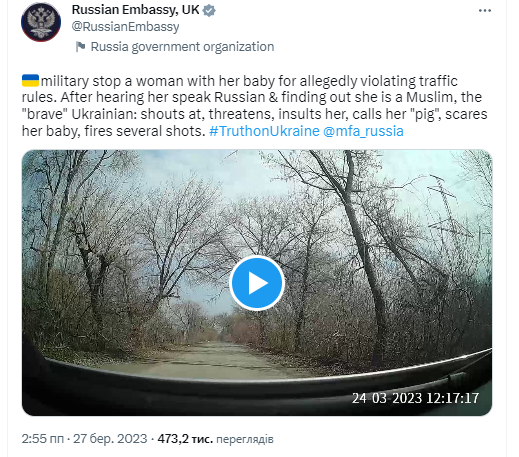
How the fake piece was debunked
- Almost immediately after the clip was posted, social media users found way too many signs pointing to the assumption that the video was a hoax:
- The video was filmed using a car video recorder, although they are prohibited in Ukraine amid martial law. But the “military” somehow paid no attention to it;
- There were no license plates on the military vehicle;
- The military vehicle was marked with the Balkenkreuz cross, which was used to mark Wehrmacht vehicles during World War 2. The Armed Forces of Ukraine use a plain white cross; and
- The sound in the video clip has clearly been doctored.
The Main Intelligence Directorate of the Ministry of Defense of Ukraine issued a detailed analysis of the fake story on March 28. They drew attention to the Russian origin of the pickup truck frame.
But this time, part of Russian propaganda resources joined the refutation effort. As soon as on the evening of March 27, the anonymous Telegram channel “Crocodile” (affiliated with the network of pseudo-Ukrainian channels, which includes “Legitymny”, “Resident”, “Sheptun,” and others) published a number of questions challenging the video.
Another anonymous channel, Moscow Calling, and propagandist blogger Anatoly Shariy made public the location where the video was shot. They claimed to have received it from their followers in Donetsk.
As it turned out, the “conflict” took place on the road between Donetsk and Makiivka. Both cities have been under occupation since 2014. Now, this is a deep rear of the Russian army, where no “AFU convoys” are moving about just yet. The authenticity of this information was confirmed by the Ukrainian defense intelligence.
Why do Russian propagandists seek to refute their own fake?
The rapid refutation of the fake story by Russia’s own propagandists may indicate the infighting between various groups of security forces for resources and point to serious tensions between them.
In addition, the demonstrative exposure of the fake by Shariy and admins of other Telegram channels is a tool for increasing confidence in their sources and attracting a new audience by throwing competitors under the bus. In the future, they can use gained trust to:
- spread more important Russian narratives and disinformation and
- refute reliable information, now as “Ukrainian fakes”.
What happened after the refutation
After the fake was refuted, some of the resources removed the video without comment or apology. This was done by the admins of Telegram channels of Vladimir Solovyov, Siloviki RU, and the Twitter account of Russia’s MFA. Yet, the post remained on the Twitter profile of the Russian embassy in London, despite a large number of comments exposing the fake.
Telegram channels “Zapiski Veterana” and “Rybar” kept the old publications, noting that the video turned out to be false.
They did the same on the “Dvach” Twitter account. The message has been removed from the Telegram channels run by this platform.
However, the majority of news resources and social media admins ignored the refutations. The fake was actively circulated on March 28 and began to decline only the following day.
What is the connection of the video with the desecration of the Quran?
There is every reason to consider the fake story about the road conflict part of an information campaign to discredit Ukrainians in the eyes of the Muslim community. Earlier, another hoax video appeared online where individuals posing as Ukrainian soldiers were cutting pork fat on the Quran and burning its pages for show.
The conflict video contains no direct mentions of Islam. But there are a few hints:
- The “victim’s” last name is Mustafayeva, which is a common last name among Muslims in the post-Soviet space;
- After the last name is announced, the “soldier” calls the woman a “pig,” which is a huge offence for any Muslim; and
- The video appeared during the holy month of Ramadan, being dated March 24, one of its first days.
Thus, in addition to promoting the general narrative of “an attack by armed Ukrainian Nazis on a defenseless woman and child,” the video bore additional messages sewn into it for a narrower Muslim audience.
The vehicle for promoting the narrower narrative was the anonymous Telegram channel Dva Mayora, which published a long read about discrimination based on religion, language, and ethnicity allegedly being Ukraine’s national policy.
This trend was supported by Telegram channels of Russian military correspondents, as well as resources with the target audiences in the predominantly Muslim regions of Russia, primarily Chechnya, Dagestan, Adygea, etc.
At the same time, Tsargrad TV and other far-right resources promoting radical Orthodox values and Russian chauvinism ignored the Muslim component.
The Telegram channel “Armenians of Russia” did the same. Its target audience is not too friendly toward Muslims due to the long-dragging ethnic conflict with the Azerbaijanis and the war in Karabakh.
This is not the first time that the Russians have tried to promote fake information about chauvinism and Islamophobia, which they falsely claimed is allegedly widespread in Ukraine. This is done both to dehumanize Ukrainians and to mobilize representatives of the Muslim peoples of Russia to participate in the war of aggression. Against the background of problems with the recruitment of reservists in Dagestan and Chechnya, the Kremlin is trying to come up with a motivation for the populations of these republics to “protect their faith.”
Center for Strategic Communication and Information Security

